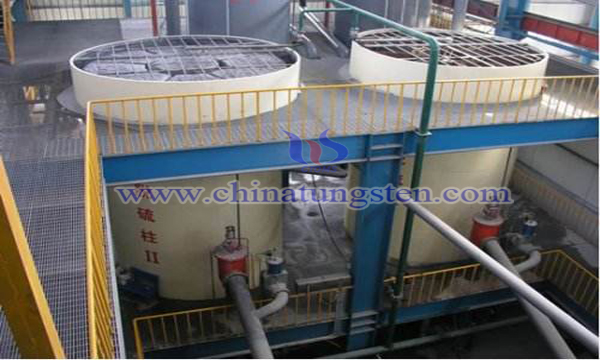Scheelite Decomposition by Sodium Silicate
- Details
- Category: Tungsten Information
- Published on Monday, 30 December 2019 20:35
Sodium hydroxide decomposition is the main process for tungsten mineral raw materials. In the alkaline system, phosphorus, arsenic, silicon, molybdenum, tin and other elements contained in the mineral are leached to varying degrees and become the main impurities in the crude sodium tungstate solution. Some scholars have found that when sodium hydroxide decomposes tungsten ore, the calcium content of raw materials is beneficial to inhibit the leaching of impurities such as phosphorus, arsenic and silicon, and the leaching rate of these impurities decreases with the increase of calcium content.

The results show that the oxy acids of phosphorus, arsenic and silicon can form insoluble compounds with calcium, and these precipitates can still exist stably under the condition that scheelite has been decomposed. Because of this, in the purification process of crude sodium tungstate solution, adding appropriate amount of Ca(OH)2 can also remove the above three impurities. The precipitation rates of phosphorus, arsenic and silicon can reach 99.04%, 96.94% and 97.93% respectively.
Thermodynamic analysis shows that scheelite can be decomposed by sodium silicate. With the increase of pH value, the decomposition products were CaSiO3 and Ca3Si2O7. In the stable region of CaSiO3 with low pH value, the concentration of tungsten in the solution is relatively low; in the stable region of Ca3Si2O7 with high pH value, sodium hydroxide also participates in the decomposition reaction, and the concentration of tungsten increases rapidly with the increase of pH value. Therefore, appropriate sodium hydroxide should be added when sodium silicate decomposes scheelite.
The possibility of decomposition of scheelite by sodium silicate was verified. The results show that the amount of sodium silicate is an important factor affecting the overall level of leaching. Increasing the concentration of reagents and adding a certain amount of sodium hydroxide can further improve the leaching rate. Under the conditions of decomposition temperature 180 ℃, decomposition time 4 h, n (SI) / N (W) = 2.0, n (OH -) / N (W) = 0.5, n (H2O) / N (W) = 35.3, the leaching rate of tungsten is 96.9%.
The results of theoretical analysis are verified by decomposition experiments, and the trend of actual decomposition effect is consistent with that of thermodynamic analysis. The amount of sodium silicate is an important factor to affect the overall level of leaching. Increasing the concentration of reagents or adding sodium hydroxide can further improve the leaching rate of tungsten. When the mass fraction of WO3 is 55.0%, the decomposition temperature is 180 ℃, the decomposition time is 4 hours, and the molar ratio of silicon to tungsten, hydrogen peroxide to tungsten, water to tungsten is 2.0, 0.5 and 35.3, respectively, the leaching rate of tungsten is 96.9%.
- Tungsten Oxide Manufacturer & Supplier, Chinatungsten Online: www.tungsten-oxide.com
- Tungsten News & Prices of China Tungsten Industry Association: www.ctia.com.cn
- Molybdenum News & Price: news.molybdenum.com.cn
- Tel.: 86 592 5129696; Fax: 86 592 5129797; Email: sales@chinatungsten.com



 sales@chinatungsten.com
sales@chinatungsten.com